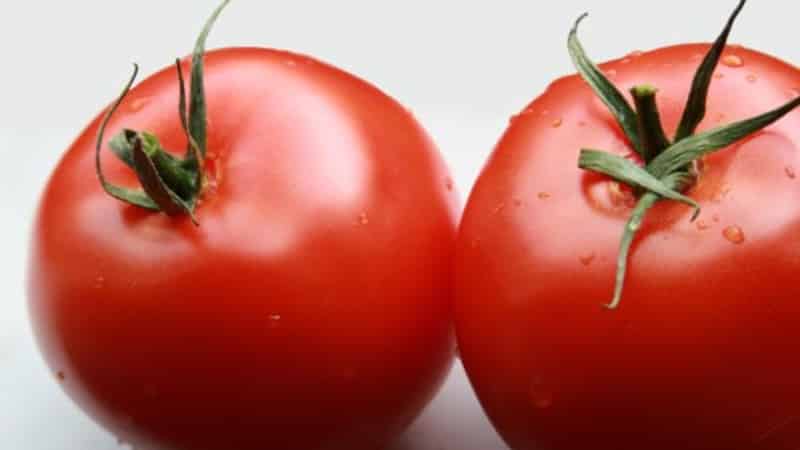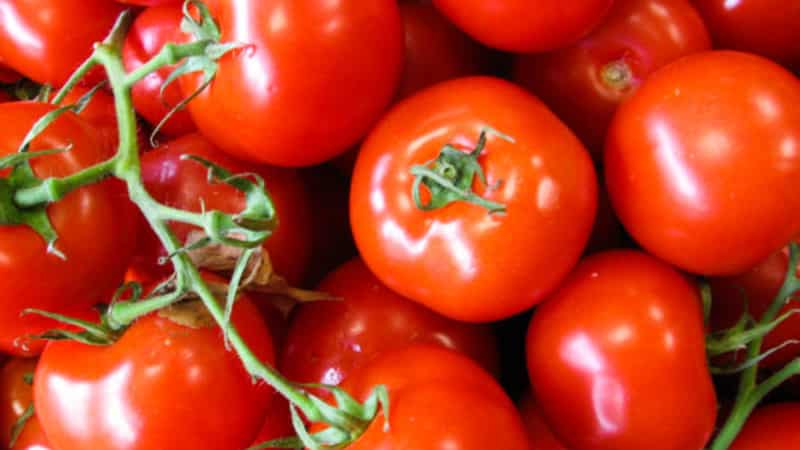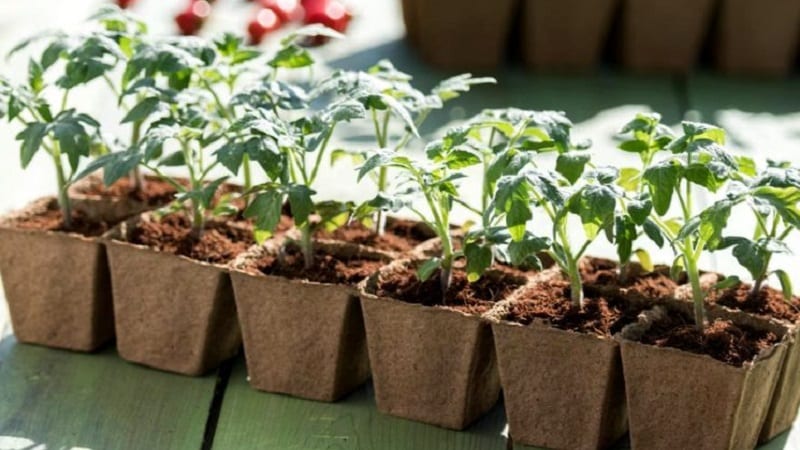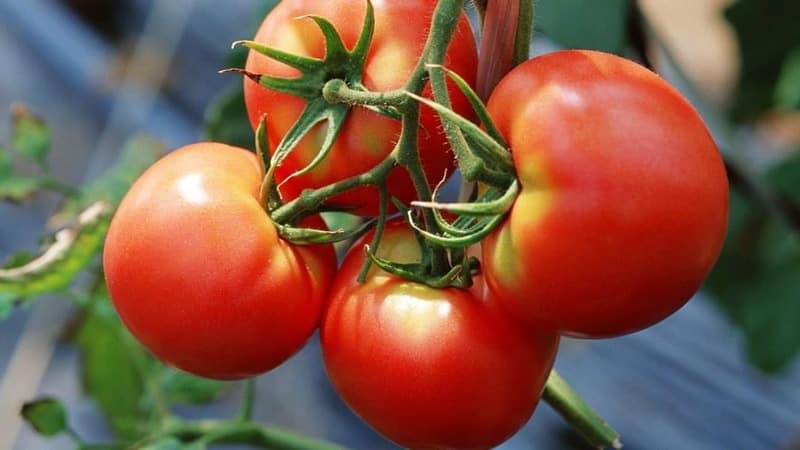A new hybrid with powerful bushes and an abundant harvest of tomatoes - tomato "Katrina f1"
When choosing a tomato variety for their plot, summer residents are often tormented by doubts about what is best to plant? Large-fruited or, conversely, smaller? For summer salads or for pickles and marinades?
Often, the lack of space does not allow planting many varieties, but you really want to eat plenty in the summer and prepare for the winter. It is for the sake of variety that the Katrina tomato was created, allowing you to enjoy ripe vegetables of excellent taste both in summer and winter. Let's get to know him better.
Characteristics and description
The originator of the hybrid tomato Katrina f1 is Lyubov Anatolyevna Myazina. The culture was included in the State Register in 2008. It is recommended for cultivation in open ground and greenhouse conditions.
Reference. Myazina L.A. is a famous Russian breeder, the author of not only tomato crops, but also the creator of cucumbers and peppers.

Distinctive features
The culture belongs to the determinant type, height from 60 cm to 1.2 m. The foliage is medium, the leaves are small, bright green. The stem is strong, but plant staking is required. The inflorescences are simple. Each fruiting branch bears 5–7 fruits in all weather conditions.
When breeding in open ground, bush formation and pinching are not required.
An early ripening hybrid, 85–95 days pass from the moment of sowing the seeds to full ripening. Productivity is high, from 1 sq. m, up to 5 kg of fruits are collected, when placing 4–5 seedlings per 1 sq. m.
The hybrid genes contain high resistance to dangerous diseases the nightshade family.
Fruit characteristics
Average weight 150–200 g, round shape, bright red color. The taste is excellent, the flesh is juicy. The skin is dense and does not crack, which allows you to store ripe vegetables for a long time and transport them over any distance. Tomatoes can also withstand heat treatment, so the fruits look great when preserved.
Taste qualities go well with yellow tomatoes, therefore they are often mixed in winter preparations, obtaining not only a beautiful appearance, but also an excellent taste. Ripe vegetables are great for preparing any fresh dishes and for processing into tomato products.
The photo shows tomatoes Katrina f1.

How to grow seedlings
Many varieties are grown in seedlings and the Katrina tomato is no exception. It will not be possible to collect seed material on your own, since the crop is hybrid.
Seed preparation
As a rule, before releasing seed for sale, the manufacturer takes care of the quality of the product. That's why purchased seeds are not disinfected; they are already disinfected and ready for sowing. But to improve germination, grains are soaked in a growth stimulator for 10 hours. As soon as the seeds swell, they are sown in the ground.
Reference. Most often, the drug “Epin” or melt water is used as a stimulant.
Container and soil
The soil is prepared from garden soil mixed with humus and wood ash in equal quantities.. Superphosphate is added to the resulting mixture as fertilizer. After thorough mixing, the soil is steamed in the oven at a temperature of 50 ° C for 15 minutes or spilled with a hot solution of potassium permanganate. In this way, pathogenic flora is destroyed.
Reference. Self-prepared soil is subject to mandatory disinfection. Pathogenic spores contained in the soil can cause irreparable harm to young plants.
After the soil has cooled, it is laid out in planting containers, filling them halfway. Subsequently, as the seedlings grow, soil is poured into containers, providing the necessary nutrition throughout the entire seedling period.

You can plant in a common wooden box and in separate cups: plastic or peat. Peat cups are considered an ideal option for growing seedlings, since the seedlings do not need to be picked and transplanted into the soil from a container - the seedlings are lowered into the holes along with the cup. This is due to the fact that the tomato tolerates picking and transplanting too painfully, and then takes a long time to take root in the new conditions.
Important! Picking and replanting will delay the fruiting period.
Sowing
Seeds are sown 2 months before planting in the ground.. They are buried 1 cm with a distance of 2 cm from each other. Sprinkle soil on top and lightly compact. Moisten with warm, settled water from a spray bottle and cover with film to create greenhouse conditions.
After this, the seeded containers are left in a bright and warm room. at a temperature of 22–24 °C. At temperatures below 18 °C, seedlings will appear later and seedlings will noticeably lag behind in development.
Read also:
Tomato "Bogata Khata F1" - a rich early harvest of excellent tomatoes
Seedling care
When seedlings appear, the containers are placed on the windowsill, but not in direct sunlight, otherwise the young bushes will get burned.
Water moderately from a shallow watering can with warm, settled water.. There is no need to flood the sprouts; excess moisture will not be beneficial, but, on the contrary, will have a negative effect on the root system. After watering, the soil is loosened with a wooden stick. This improves the air permeability of the soil.
When growing seedlings in a common container, they must be picked after two true leaves appear. It should be replanted into a separate container together with a large lump of earth, having first moistened the soil well. Otherwise, the seedlings will take a long time to take root after picking. With weak growth, seedlings are fed with liquid fertilizer for tomato seedlings.
Two weeks before planting in the ground, the seedlings are hardened outdoors at a temperature of at least 16 °C. Initially, the time spent on the street is no more than one hour, then it is increased to 9–11 hours. The night temperature in the room is reduced to 13 °C.

How to grow tomatoes
Transplantation is carried out as soon as 6–7 true leaves are formed on the bushes, and the soil will warm up to 15 °C. The soil is prepared in the fall - it is dug up and a complex of mineral fertilizers is applied.
Landing
In spring, the soil is dug up again two weeks before transplanting. The holes are made no deeper than 20 cm and put a little superphosphate on the bottom of each. Replant in clear weather in the evening after sunset.
Planting scheme: 40 cm is the distance between seedlings, 50 cm is left between rows. For 1 sq. m place no more than six plants.
The holes are covered with earth and watered with warm, settled water.. The plants get used to the new place within ten days. During this time, they are not watered or fed, since all the seedlings’ efforts are aimed at adaptation.
Further care for the Katrina tomato
Tomato does not require close attention and complex agricultural technology. Proper care comes down to regular moderate watering and timely application of fertilizing.
RegularOlives are installed as the seedlings take root in a permanent place. Water as the top soil layer dries out, without flooding the plants. The water is settled and heated in large barrels exposed to the sun, since the hybrid does not like cold water.
After watering, the soil is loosened and hilled to improve oxygen access to the roots.. To keep the beds moist longer, they are mulched. The culture responds well to drip irrigation. To do this, place a plastic bottle without a bottom in the root system and fill it with water.
The minimum amount of fertilizing is three times throughout the entire season.. The fertilizer is a complex of mineral compounds or organic matter. It is not recommended to feed the crop with fresh manure, due to which the green mass increases without the formation of ovaries. From organic matter, use mullein infusion or bird droppings in a ratio of 1:15.
During flowering, add to the fertilizer boric acid, and during the fruiting period - potassium salts.

Features of care and possible difficulties
When grown in open ground, the crop does not require any pinching, nor the formation of a bush. This significantly facilitates care during the growing season.
Despite the determinant type, the plant requires obligatory gartering of the stem and fruit-bearing branches. With timely fixation to the support, the stem is formed strong and even, making it much easier for it to withstand the weight of the ovaries. As they grow, fruit-bearing branches are fixed to the support, otherwise the fruits may rot if they come into contact with wet beds.
The lower leaves up to the first fruiting cluster are removed for the same reason, so that they do not come into contact with wet soil.Rotting foliage will lead to the spread of fungal diseases.
Diseases and pests
Prevention is carried out if peppers or potatoes are planted next to the tomato.. These crops belong to the same family, suffer from the same diseases and are affected by the same pests.
The Colorado potato beetle, whitefly and aphid. A soap solution used to treat the plant stem will get rid of aphids, and the drug “Prestige” will be used to get rid of the Colorado potato beetle. But if there are few pests, a thorough inspection of each seedling will help. The beetle is collected by hand along with its larvae.
Whitefly - a butterfly that causes damage directly to the leaves, causing them to wither and fall off. To combat it, pheromone traps are placed next to the seedlings and strong-smelling herbs are planted. The smell of such herbs repels not only whiteflies, but also other pests.
Reference. Pheromone traps capture only pests without causing any harm to other insects.
For the prevention of fungal diseases seedlings are sprayed with copper-containing preparations or a manganese solution. Also use "Fitosporin", which helps not only in prevention, but also in the fight against the disease.

Nuances for open ground and greenhouse conditions
The hybrid is recommended for breeding in all regions, but depending on the growing conditions, the care conditions also change.
In a greenhouse, a hybrid is planted much less frequently than in open ground.: leave 50 cm between seedlings, 70 cm between rows. Under this placement condition, each bush will receive the required amount of light and will be able to be ventilated. Densified plantings will lead to the spread of fungal diseases and pests.Protected structures are regularly ventilated so that temperature and humidity do not exceed the norm. Healthy growth and development of plants depends on these indicators.
If bush formation is not carried out in open ground, then in greenhouse conditions you cannot do without it.. The plant is formed into 2 or 3 stems, removing all excess stepsons, otherwise the quantitative indicator of fruiting will be underestimated.
Before planting in a greenhouse, the walls are treated with Bordeaux mixture, and the ground is spilled with copper sulfate to destroy pathogenic flora.
Harvesting and application
Early ripening fruits ripen quickly and smoothly. If the branches are tied, then harvesting is not difficult. Ripe vegetables are tasty and juicy, so they are great for fresh salads, hot and vegetable dishes, slices and various snacks. They are also good in canning, pickles and marinades. They make excellent juices, pastes, adjika and sauces.
Thanks to its strong skin and dense pulp tomatoes are transported to any distance without losing their presentation.

Advantages and disadvantages of a hybrid
Many of those who grew crops in their garden highlight undeniable advantages of a hybrid:
- takes root in all regions;
- forms ovaries in any climate;
- adapts to sudden changes in temperature;
- cold-resistant;
- easy to care for;
- does not require pinching and shaping;
- early ripening;
- strong immunity to diseases;
- high-yielding species;
- excellent taste of fruits;
- long transportation;
- universal application.
The disadvantages include gartering plants and forming a bush in a greenhouse.
Farmer reviews
The hybrid has many fanswho plant it every year and share their reviews on online forums.
Margarita, Moscow region: “I really like the hybrid. The plant is completely unpretentious, does not need careful care, and, most importantly for me, tomatoes are not afraid of temperature changes. Our summer is not always warm; lately there has been a lot of rainfall and it is often windy. Nevertheless, the tomato takes root well in the beds and pleases with a large harvest.".

Ekaterina, Stavropol: “I really love making preparations for the winter, so I spent a long time looking for suitable tomatoes. I liked the Katrina tomatoes, their fruits weigh up to 200 g, are juicy, meaty, with a pleasant sweet and sour taste. It is also important that plants have high immunity and tolerate unfavorable environmental conditions well.”.
Conclusion
Hybrid Katrina f1 is an excellent solution for those who grow tomatoes not only for summer dishes, but also for winter preparations. Plants do not get sick during the growing season, do not require complex care and adapt well to any climatic conditions.
With such characteristics, it is not surprising that the hybrid is bred in all regions and only positive reviews are left about it.